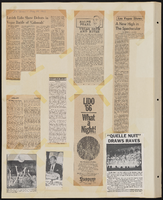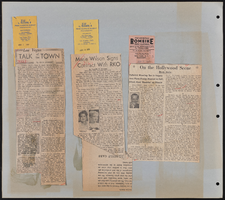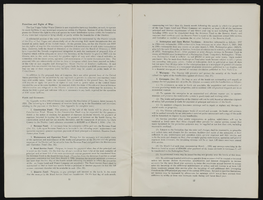Search the Special Collections and Archives Portal
Search Results
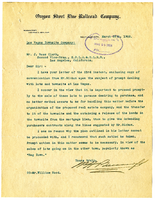
Letter from W. H. Bancroft to J. Ross Clark, March 26, 1905
Date
Archival Collection
Description
Text
Suzette Cox oral history interview
Identifier
Abstract
Oral history interview with Suzette Cox conducted by Andrew Lazarus on March 15, 1981 for the Ralph Roske Oral History Project on Early Las Vegas. Suzette Cox discusses her experiences living in Las Vegas, Nevada. She then discusses her careers in the police departments and a local newspaper company. Topics also included racial discrimination, sports, and how the development of the Strip influenced her life while attending school in Las Vegas, as well as its relation to tourism and aboveground atomic testing.
Archival Collection
Larry Cooper oral history interview
Identifier
Abstract
Oral history interview with Larry Cooper conducted by Claytee D. White on March 05, 2018 for the African Americans in Las Vegas: a Collaborative Oral History Project. In this interview, Cooper discusses his early life in Las Vegas, Nevada and growing up in the Westside. He talks about his educational experiences in Las Vegas, attending the Arkansas Agricultural, Mechanical and Normal College (now University of Arkansas at Pine Bluff), and teaching mathematics. Cooper recalls his employment at Southwestern Bell Telephone Company, becoming Vice President of Emerging Markets, and relocating around the United States for work. He remembers moving back to Las Vegas in the mid-2000s, his friendship with civil rights leader Jimmy Gay, and the contributions Gay made for the African American community. Cooper describes Westside businesses, and casinos on Jackson Street. Lastly, Cooper discusses the future of the Westside.
Archival Collection
Roy Waite oral history interview
Identifier
Abstract
Oral history interview with Roy Waite conducted by Dale Haley in approximately 1974 for the Ralph Roske Oral History Project on Early Las Vegas. Waite begins by discussing his athleticism, being a part of the first basketball team in Las Vegas, Nevada, and his general store in Bunkerville, Nevada. Waite lists the different social organizations and boards he was affiliated with, describes the arrival of the railroads, and the ranch he used to own near Bunkerville. He talks about the construction of Hoover Dam (Boulder Dam) and how Southern Nevada has changed socially and environmentally. Waite also discusses smelting lead for bullets and relocating Native American remains away from a grave site that would be submerged by Lake Mead.
Archival Collection
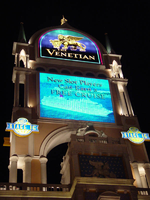
Photographs of Venetian sign, Las Vegas (Nev.), 2002
Date
Archival Collection
Description
Site name: Venetian (Las Vegas, Nev.)
Site address: 3355 S Las Vegas Blvd
Sign owner: Las Vegas Sands, Inc., Sheldon Adelson
Sign details: The Venetian utilizes very little signage at all ad relies heavily on the architecture and themed environment which it creates for its advertisements.
Sign condition: Structure 5 Surface 5 Lighting 5
Sign form: Pylon
Sign-specific description: The signage for the Venetian Hotel and Casino is limited to an architecturally integrated sign on the north end of the property, The structure is essentially a giant arch which supports two levels which hold the signage. The arch which rises out of the roof of a building has six columns on its western most exposed edge, at the base. Each section of the pylon, is flanked by sets of four columns. The top sections legs prove to be shorter, being that they are supports for crown of smaller arches. Each flanking arcade is capped with a pointing spire. The top cabinet is an internally lot log for the Venetian.
Sign - type of display: Backlit; Ambient
Sign - media: Steel; Plastic; Masonry
Sign environment: The Venetian is quite successful in creating an environment since the entire facade creates wrapping arms of architecture, ambiently lit. The ornate quatrefoils, details columns and capitals form walls of joined elements and design rotations, that turn endlessly upon one another. The giant towers perching statuary high above the pedestrians head leave those who wander near the Venetian constantly looking up. Whether in the day or night hours, the Venetians plaza creates a environment which is pedestrian friendly.
Sign designer: The Stubbins Association
Sign - date of installation: 1998
Sign - thematic influences: The theme surrounding the Venetian is suggested strongly in the name of the property as well. The architecture is modeled after that seen in the city of Venice, Italy, and stays true to the form regardless of the configuration of the collection. It falls into the category of property which is themed after a city, particularly that of European origin. Such other examples include the Paris and the Bellagio.
Surveyor: Joshua Cannaday
Survey - date completed: 2002
Sign keywords: Pylon; Backlit; Steel; Plastic; Masonry
Mixed Content
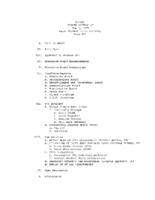
Meeting minutes for Consolidated Student Senate, University of Nevada, Las Vegas, May 1, 1979
Date
Archival Collection
Description
Text

Michael Arage oral history interview: transcript
Date
Archival Collection
Description
Oral history interview with Michael Arage conducted by Dalton DuPré on November 12, 2021 for Reflections: The Las Vegas Asian American and Pacific Islander Oral History Project. In this interview, Michael Arage discusses his upbringing in the Greater Toronto Area (GTA), Ontario, Canada with his sister and his Filipino-Palestinian heritage. He talks about how his parents immigrated to the United States, his life and education in Toronto, and his relocation to Los Angeles, California where he married his wife. Michael Arage shares how the couple moved to Las Vegas, Nevada in 2012 when his wife started a job at Zappos. Because he lacked a work visa, Michael Arage began playing poker and working in sports betting. In 2019, he founded a community organization to support the people of Palestine, called Nevadans for Palestinian Human Rights. Michael Arage talks about his activism efforts, anti-Arab racism, his cultural upbringing, and of Filipino and Arabic foods and customs. He also shares his views of living in Las Vegas, the difficulties of raising a child away from her cousins, and differing governmental policies and healthcare between Canada and the United States.
Text

